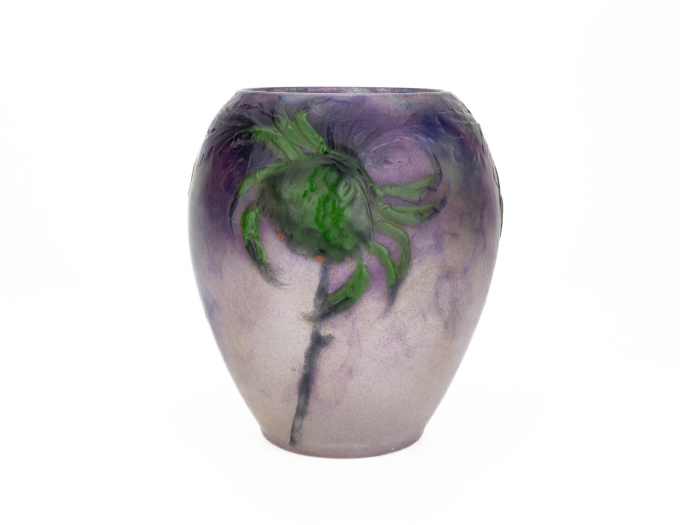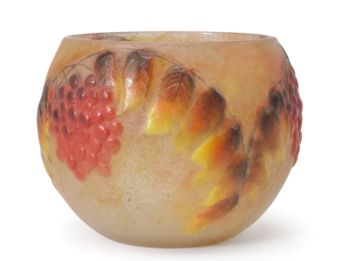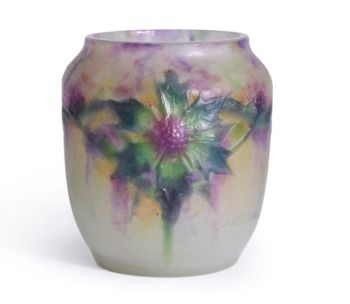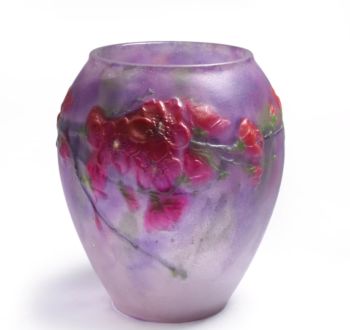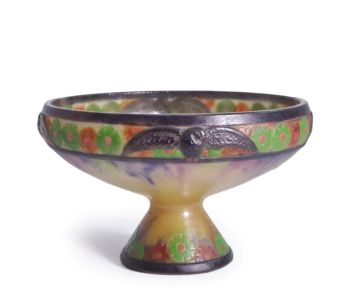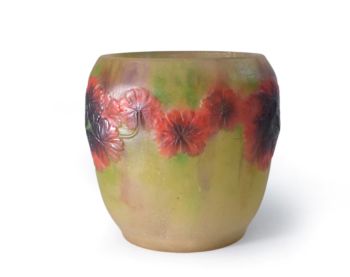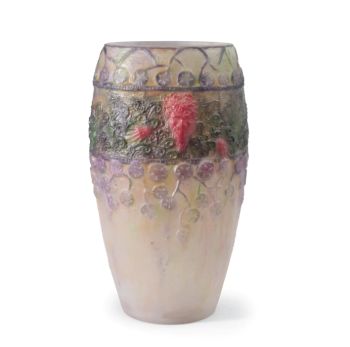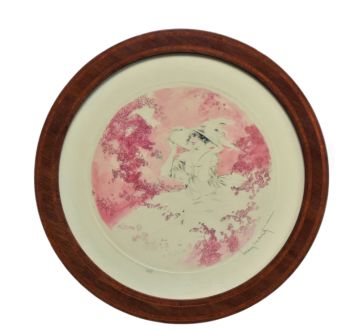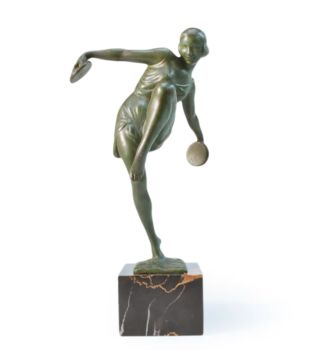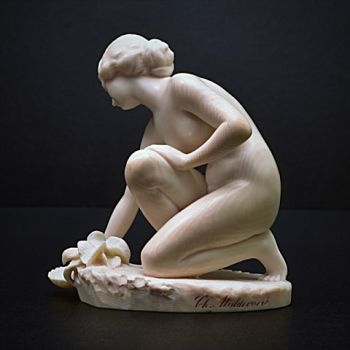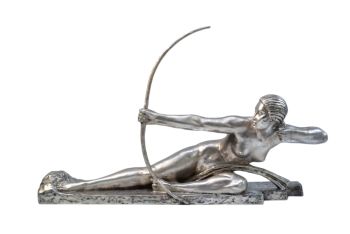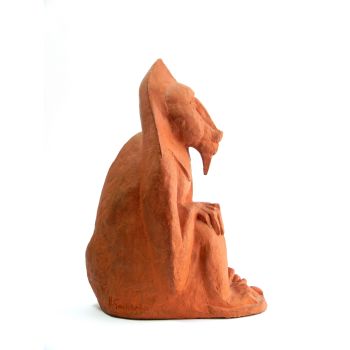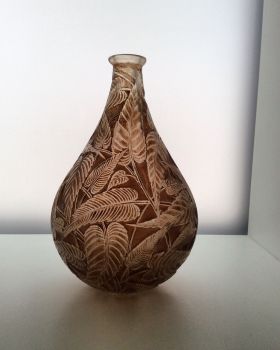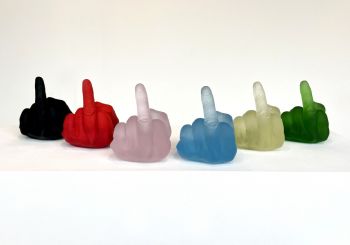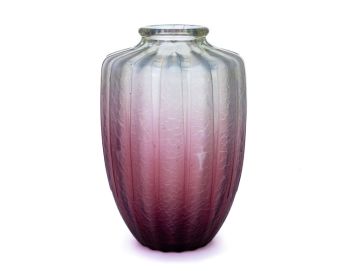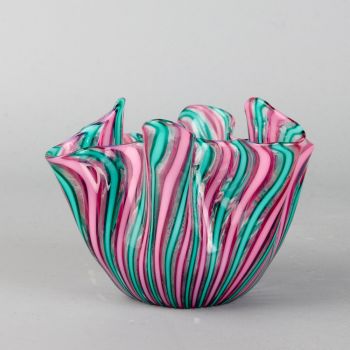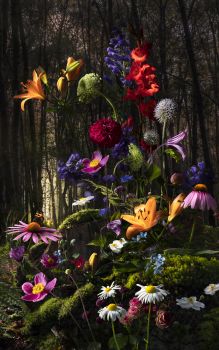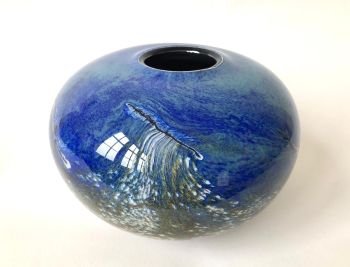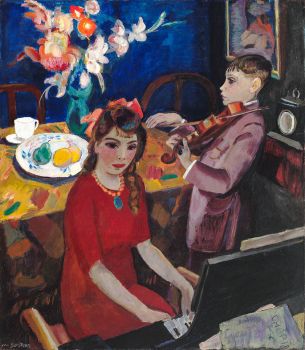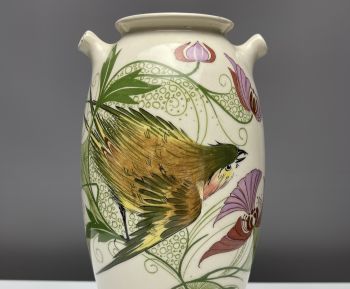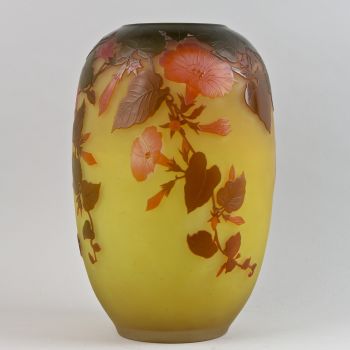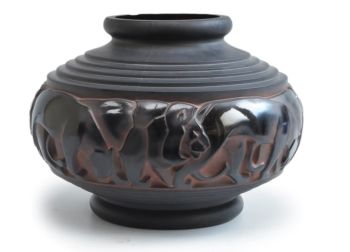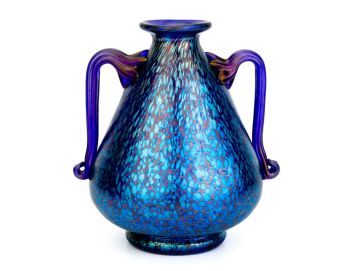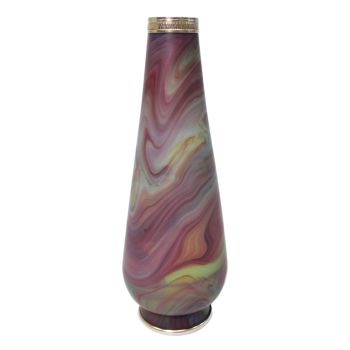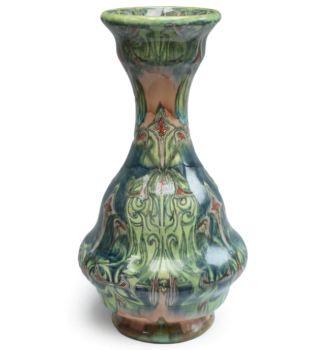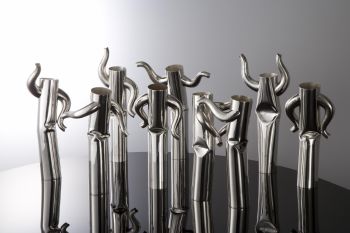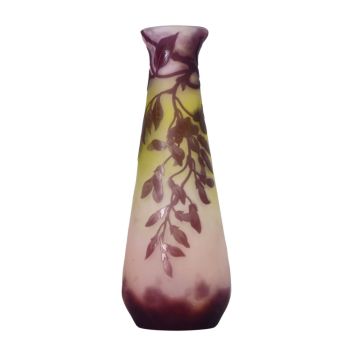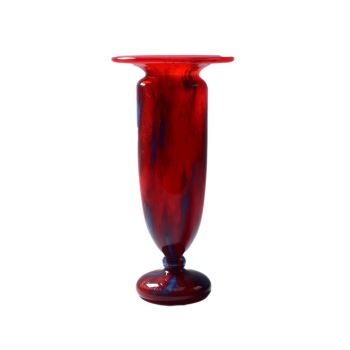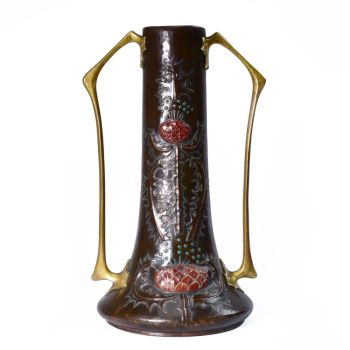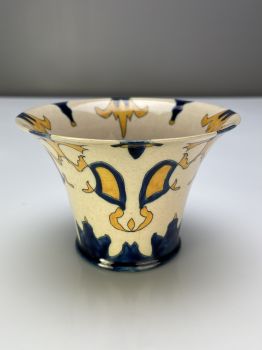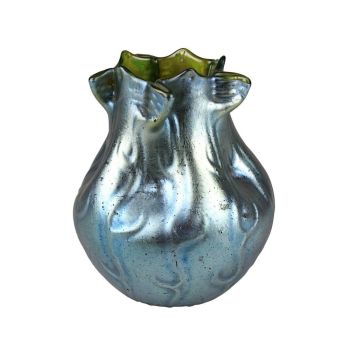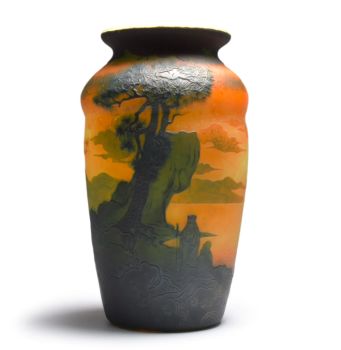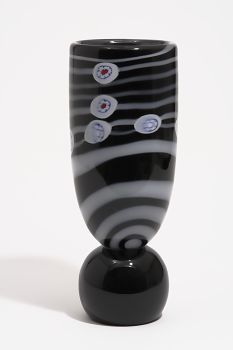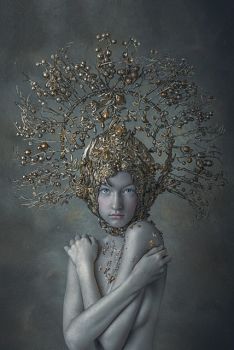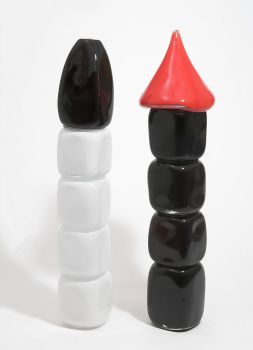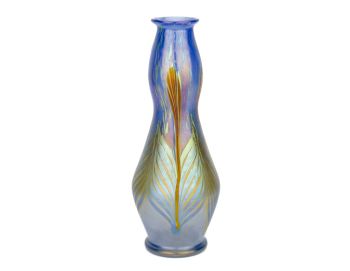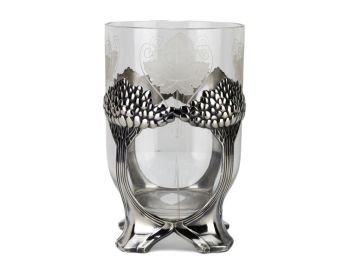Gabriël Argy-Rousseau – Crabes et Algues vase – 1920 1920 - 1929
Gabriel Argy-Rousseau
Pâte de VerreBicchiere
14 cm
ConditionMint
Prezzo su richiesta
Antiques Emporium
- A proposito di opere d'arteGabriël Argy-Rousseau (Meslay-le-Vidame 1885-1953) was a master in the technique of pâte de verre (glass paste). His refined pâte de verre objects are sought after worldwide. Each pâte de verre object is unique in color because of the production procede.
This beautiful example of French pâte de verre glass made by Gabriel Argy Rousseau is a masterpiece from his early oeuvre. The color combination of green glass on swirling shades of pruple results in a beautiful contrast and further highlights the sophistication of this design. This model was designed in the year 1920 and is named “Crabes et Algues” which is the French translation for crab and algae.
The theme of marine animals such as crabs and fish was not only loved by Argy-Rousseau, but was also frequently used by, for example, his pâte de verre colleague Amalric Walter.
The body of the vase is signed with “G. Argy-Rousseau” and the bottom of the vase with “France.”
Dimensions:
Height: 140mm / 5.51″
Diameter top rim: 80mm / 3.15″
Literature:
Janine Bloch-Dermant – G. Argy-Rousseau, Glassware As Art. Page 181 - A proposito di opere artista
Joseph Gabriel Argy-Rousseau (Meslay-le-Vidame 1885-1953) è considerato uno dei pochi grandi artisti del vetro che ha lavorato con la pâte de noche.
Il pâte de varen era stato appena riscoperto alla fine del XIX secolo da Henri Cros e Georges Despret. Ma un piccolo numero di artisti ha sviluppato i propri metodi e ricette e si è specializzato nella lavorazione della pâte de noche. Insieme a Henri Cros, Georges Despret, François Décorchemont e Amalric Walter, Gabry-Rousseau è uno dei più importanti artisti del vetro nel campo della pâte de Verre che era più trasparente.
Grazie all'amicizia all'Accademia di Sèvres con il figlio di Henri Cros, Jean Cros, Argy-Rousseau ha imparato a lavorare con la pâte de Verre e da allora ha sempre utilizzato la pâte de Verre come base per tutti i suoi disegni. La sua prima mostra al Salon des Artistes Indépendantes Française risale al 1914.
Nel 1921 Gabriel Argy-Rousseau aprì il suo studio a Parigi. "Les pates de vers d'Argy-Rousseau". Il finanziere e gallerista Gustave Moser-Millot ha ottenuto i diritti esclusivi di vendita. Ha impiegato diverse persone ma ha continuato a produrre vetro su piccola scala per tutta la sua carriera. Ad esempio, la maggior parte degli articoli è stata in gran parte prodotta a mano, ma sono state utilizzate anche tecniche semiautomatiche per i modelli più semplici. I suoi disegni sono stati sempre prodotti in piccole serie.
Nel 1925 era all'apice della sua fama. Tuttavia, anche a causa della crisi economica, nel 1931 fu costretto a chiudere il suo studio. Successivamente ha iniziato a lavorare come artista indipendente in un piccolo studio ea realizzare solo pezzi unici. Visse in grande povertà ma rimase attivo.
Il lavoro di Argy-Rousseau è piuttosto raro e quindi piuttosto costoso. Molte grandi collezioni, sia museali che private, hanno un'opera di Argy-Rousseau nella loro collezione.
Gabriel Argy-Rousseau morì nel 1953.
Sei interessato ad acquistare questa opera d'arte?
Artwork details
Related artworks
- 1 - 4 / 8
- 1 - 4 / 24
Johann Loetz (Lötz) Witwe Klostermühle
Johann Loetz Witwe – Ausfuehrung 146 Titania vase – 19121910 - 1919
Prezzo su richiestaAntiques Emporium
Johann Loetz (Lötz) Witwe Klostermühle
Johann Loetz Witwe - Phänomen Genre 7773 – Orange1900 - 1910
Prezzo su richiestaAntiques Emporium
1 - 4 / 24Johann Loetz (Lötz) Witwe Klostermühle
Johann Loetz Witwe – Jugendstil Cobalt Papillon vaas1900 - 1910
Prezzo su richiestaAntiques Emporium
1 - 4 / 24Amalric Walter
Amalric Walter & Henri Bergé – Crabe plumier1920 - 1929
Prezzo su richiestaAntiques Emporium
Artista Sconosciuto
Gobelet vénitien ailé1650 - 1700
Prezzo su richiestaPeter Korf de Gidts - Antiquairs
Artista Sconosciuto
EIGHT NEO-GOTHIC STAINED GLASS WINDOWS WITH SUSPENSION EYELET, 19th C, BELGIUM.1850 - 1900
Prezzo su richiestaSpectandum Gallery
Johann Loetz (Lötz) Witwe Klostermühle
Johann Loetz Witwe – Jugendstil Cobalt Papillon vaas1900 - 1910
Prezzo su richiestaAntiques Emporium
1 - 4 / 24Frères Daum
Daum Nancy – “Paysage Soleil Couchant” vase with two applied handles1900 - 1910
Prezzo su richiestaAntiques Emporium
Johann Loetz (Lötz) Witwe Klostermühle
Johann Loetz Witwe – Jugendstil Cobalt Papillon vaas1900 - 1910
Prezzo su richiestaAntiques Emporium
Johann Loetz (Lötz) Witwe Klostermühle
Johann Loetz Witwe – Phänomen Genre vaas in blauw opaal – 19021902 - 1903
Prezzo su richiestaAntiques Emporium
Johann Loetz (Lötz) Witwe Klostermühle
Johann Loetz Witwe - Phänomen Genre 7773 – Orange1900 - 1910
Prezzo su richiestaAntiques Emporium
Firm Erhard & Sohne, Schwäbisch Gmünd
Erhard und Söhne – Jugendstil intarsia klok – 1908 / 19091900 - 1909
Prezzo su richiestaAntiques Emporium
Johann Loetz (Lötz) Witwe Klostermühle
Johann Loetz Witwe – Ausfuehrung 146 Titania vase – 19121910 - 1919
Prezzo su richiestaAntiques Emporium
Artista Sconosciuto
François-Théodore Legras – Tall “Fleurs de Pommier” apple blossoms vase1900 - 1909
Prezzo su richiestaAntiques Emporium
1 - 4 / 12


